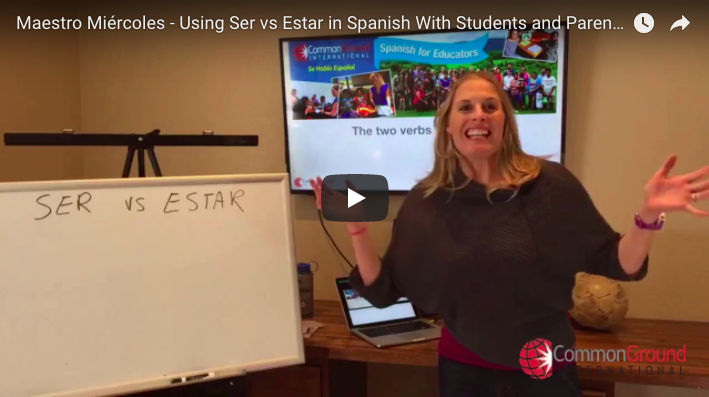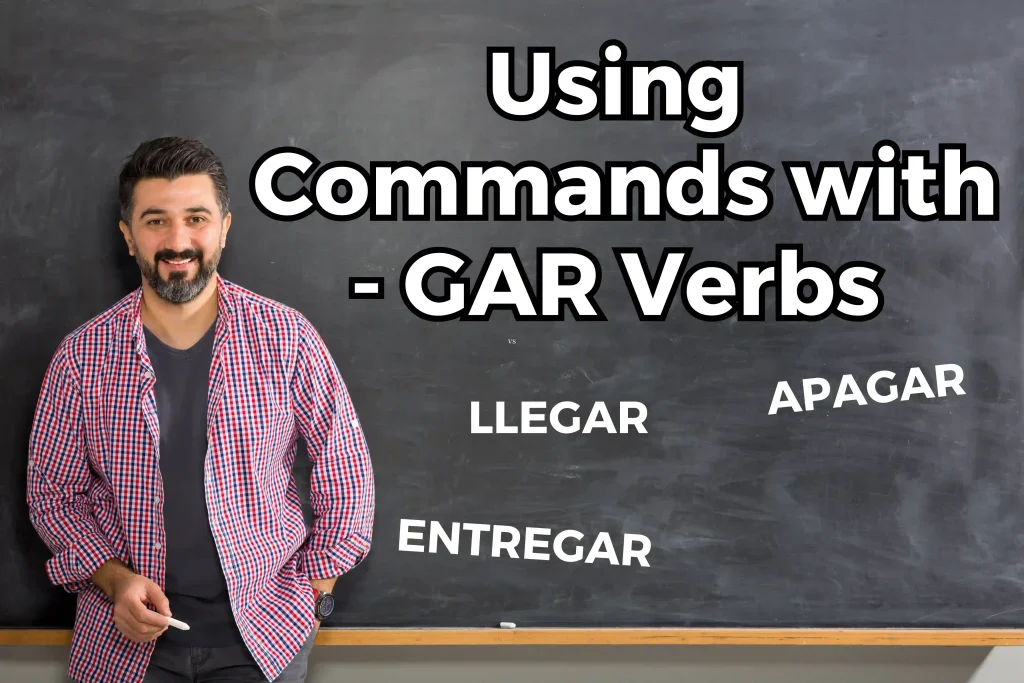This Spanish for Educators lesson focuses on learning how to use Ser vs Estar in Spanish: The Verbs “to be”. Su reto profesional: aplicar este vocabulario con sus estudiantes y padres o tutores y poner sus usos en español en los comentarios.
Here is Spanish lesson all about Ser vs Estar in Spanish I taught to the Facebook group:
Subscribe to our YouTube Channel to see all of our lessons and get the latest videos right away!
Las conjugaciones de SER | |
|---|---|
| Yo…Soy | I…Am |
| Tú…Eres | You…Are |
| Él, Ella, Usted…Es | He, She, (You)… Is |
| Nosotros…Somos | We…Are |
| Vosotros…Sois | You… Are |
| Ellos, Ellas, Ustedes…Son | They, You…Are |
Las conjugaciones de ESTAR | |
|---|---|
| Yo…Estoy | I…Am |
| Tú…Estás | You…Are |
| Él, Ella, Usted…Está | He, She, (You)… Is |
| Nosotros…Estamos | We…Are |
| Vosotros…Estáis | You… Are |
| Ellos, Ellas, Ustedes…Están | They, You…Are |
Unos ejemplos….
El problema…
| En inglés solamente tenemos: | |
|---|---|
| I: am | Yo: ¿soy o estoy? |
| You: are | Tú: ¿eres o estás? |
| He, She, it: is | Él, Ella, Eso, Esa: ¿es o está? |
| We: are | Nosotros, Nosotras: ¿somos o estamos? |
| Y’all: are | Ustedes: ¿son o están? |
| They: are | Ellos, Ellas: ¿son o están? |
| En español tenemos que escoger: | |
|---|---|
| Soy vs Estoy | (I) am |
| Eres vs Estás | (You) are |
| Es vs Está | (She, He, It) is |
| Somos vs Estamos | (We) are |
| Sois vs Estáis | (You) are |
| Son vs Están | (They) are |
¿Cómo escogemos?¿Cómo elegimos?
If you have studied Spanish before, you might have been taught the two ways below as easy ways to remember when to use which verb. Both these ways are great, especially for beginners, but they are also very general and it is easy to start finding the exceptions that don’t fit these rules once you start digging a bit deeper. I would like to teach you two other ways to think about how to use SER and ESTAR that are a bit more specific and incorporate some of the exceptions that you might find in the uses below.
| Permanent vs Temporary (Ser for permanent and Estar for temporary) |
| Twinkle, Twinkle use ESTAR for: How you feel & Where you are |
Tenemos que pensar en contexto…
It is important to consider the context when using these verbs. If acronyms help you, you will want to to use the acronyms CORTO (for uses of SER) and PLACE (for uses of ESTAR) to help you out.
SER – “Corto”
| C: characteristics |
| O: occupation |
| R: relationship |
| T: time |
| O: origin |
ESTAR – “place”
| P: position |
| L: location |
| A: action |
| C: condition |
| E: emotion |
“CORTO” para los usos de SER | |
|---|---|
| C: characteristics (physical, personality, etc.) | C: características (físico, personalidad, etc.)
Rory is tall, blonde, intelligent, very handsome. |
| O: occupation
• Yo soy instructora de español. | O: ocupación
I am a Spanish instructor. |
| R: relationship
• Rory es mi esposo. | R: relación
Rory is my husband. |
| T: time
• Hoy es miércoles y son las 11 de la mañana. | T: la hora
Today is Wednesday and it’s 11 in the morning. |
| O: origin | O: origen
I’m not from Costa Rica. I’m from Colorado |
Ahora intenta tú… | |
|---|---|
| El proyector (es / está) prendido.
El proyector está prendido. | ESTÁ
The projector is on. (Place = position) |
| Muchos hispanohablantes (son / están) obreros de construcción aquí en Denver
Muchos hispanohablantes son obreros de construcción aquí en Denver. | SON
Many Spanish speakers are construction workers here in Denver. (Corto = occupation) |
| La mamá del estudiante (es / está) preocupada. | ESTÁ
The student’s mom is worried. (Place = emotion) |
| Son las 3…¿Dónde (es / está) la familia de Rodrigo?
¿Dónde está la familia de Rodrigo? La familia está en camino. | ESTÁ
Where is Rodrigo’s family? The family is on the way. (Place = action) |
| Los piojos (son / están) un problema grande.
Los piojos son un problema grande. | SON
Lice are a big problem. (Corto = characteristics) |
| ¿Qué hora (es / está)?
¿Qué hora es? Son las 12:15 de la tarde. | ES
What time is it? It’s 12:15 in the afternoon. (Corto = time) |
| La clase de ciencias (es / está) en el segundo piso. | ESTÁ
Science class is on the second floor. (Place = location) |





